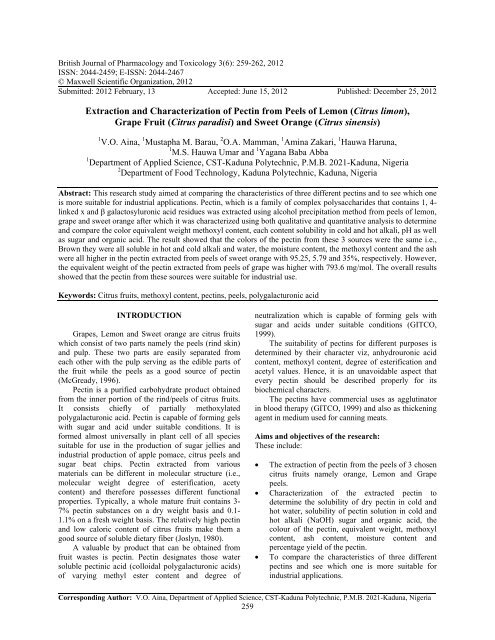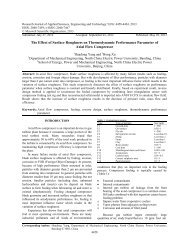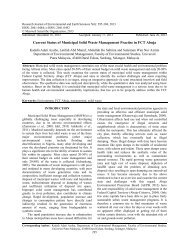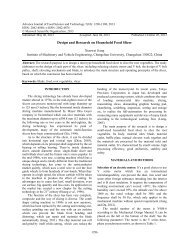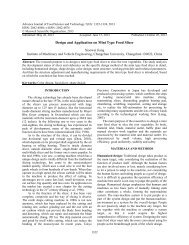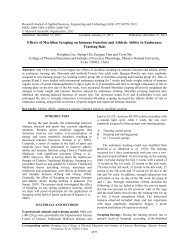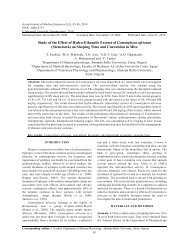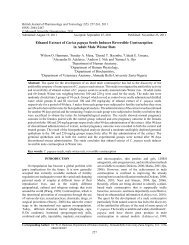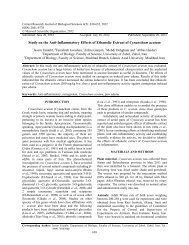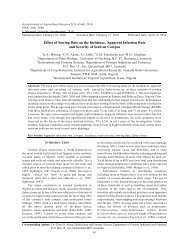Extraction and Characterization of Pectin from ... - Maxwell Science
Extraction and Characterization of Pectin from ... - Maxwell Science
Extraction and Characterization of Pectin from ... - Maxwell Science
Create successful ePaper yourself
Turn your PDF publications into a flip-book with our unique Google optimized e-Paper software.
British Journal <strong>of</strong> Pharmacology <strong>and</strong> Toxicology 3(6): 259-262, 2012<br />
ISSN: 2044-2459; E-ISSN: 2044-2467<br />
© <strong>Maxwell</strong> Scientific Organization, 2012<br />
Submitted: 2012 February, 13 Accepted: June 15, 2012 Published: December 25, 2012<br />
<strong>Extraction</strong> <strong>and</strong> <strong>Characterization</strong> <strong>of</strong> <strong>Pectin</strong> <strong>from</strong> Peels <strong>of</strong> Lemon (Citrus limon),<br />
Grape Fruit (Citrus paradisi) <strong>and</strong> Sweet Orange (Citrus sinensis)<br />
1 V.O. Aina, 1 Mustapha M. Barau, 2 O.A. Mamman, 1 Amina Zakari, 1 Hauwa Haruna,<br />
1 M.S. Hauwa Umar <strong>and</strong> 1 Yagana Baba Abba<br />
1 Department <strong>of</strong> Applied <strong>Science</strong>, CST-Kaduna Polytechnic, P.M.B. 2021-Kaduna, Nigeria<br />
2 Department <strong>of</strong> Food Technology, Kaduna Polytechnic, Kaduna, Nigeria<br />
Abstract: This research study aimed at comparing the characteristics <strong>of</strong> three different pectins <strong>and</strong> to see which one<br />
is more suitable for industrial applications. <strong>Pectin</strong>, which is a family <strong>of</strong> complex polysaccharides that contains 1, 4linked<br />
x <strong>and</strong> β galactosyluronic acid residues was extracted using alcohol precipitation method <strong>from</strong> peels <strong>of</strong> lemon,<br />
grape <strong>and</strong> sweet orange after which it was characterized using both qualitative <strong>and</strong> quantitative analysis to determine<br />
<strong>and</strong> compare the color equivalent weight methoxyl content, each content solubility in cold <strong>and</strong> hot alkali, pH as well<br />
as sugar <strong>and</strong> organic acid. The result showed that the colors <strong>of</strong> the pectin <strong>from</strong> these 3 sources were the same i.e.,<br />
Brown they were all soluble in hot <strong>and</strong> cold alkali <strong>and</strong> water, the moisture content, the methoxyl content <strong>and</strong> the ash<br />
were all higher in the pectin extracted <strong>from</strong> peels <strong>of</strong> sweet orange with 95.25, 5.79 <strong>and</strong> 35%, respectively. However,<br />
the equivalent weight <strong>of</strong> the pectin extracted <strong>from</strong> peels <strong>of</strong> grape was higher with 793.6 mg/mol. The overall results<br />
showed that the pectin <strong>from</strong> these sources were suitable for industrial use.<br />
Keywords: Citrus fruits, methoxyl content, pectins, peels, polygalacturonic acid<br />
INTRODUCTION<br />
Grapes, Lemon <strong>and</strong> Sweet orange are citrus fruits<br />
which consist <strong>of</strong> two parts namely the peels (rind skin)<br />
<strong>and</strong> pulp. These two parts are easily separated <strong>from</strong><br />
each other with the pulp serving as the edible parts <strong>of</strong><br />
the fruit while the peels as a good source <strong>of</strong> pectin<br />
(McGready, 1996).<br />
<strong>Pectin</strong> is a purified carbohydrate product obtained<br />
<strong>from</strong> the inner portion <strong>of</strong> the rind/peels <strong>of</strong> citrus fruits.<br />
It consists chiefly <strong>of</strong> partially methoxylated<br />
polygalacturonic acid. <strong>Pectin</strong> is capable <strong>of</strong> forming gels<br />
with sugar <strong>and</strong> acid under suitable conditions. It is<br />
formed almost universally in plant cell <strong>of</strong> all species<br />
suitable for use in the production <strong>of</strong> sugar jellies <strong>and</strong><br />
industrial production <strong>of</strong> apple pomace, citrus peels <strong>and</strong><br />
sugar beat chips. <strong>Pectin</strong> extracted <strong>from</strong> various<br />
materials can be different in molecular structure (i.e.,<br />
molecular weight degree <strong>of</strong> esterification, acety<br />
content) <strong>and</strong> therefore possesses different functional<br />
properties. Typically, a whole mature fruit contains 3-<br />
7% pectin substances on a dry weight basis <strong>and</strong> 0.1-<br />
1.1% on a fresh weight basis. The relatively high pectin<br />
<strong>and</strong> low caloric content <strong>of</strong> citrus fruits make them a<br />
good source <strong>of</strong> soluble dietary fiber (Joslyn, 1980).<br />
A valuable by product that can be obtained <strong>from</strong><br />
fruit wastes is pectin. <strong>Pectin</strong> designates those water<br />
soluble pectinic acid (colloidal polygalacturonic acids)<br />
<strong>of</strong> varying methyl ester content <strong>and</strong> degree <strong>of</strong><br />
neutralization which is capable <strong>of</strong> forming gels with<br />
sugar <strong>and</strong> acids under suitable conditions (GITCO,<br />
1999).<br />
The suitability <strong>of</strong> pectins for different purposes is<br />
determined by their character viz, anhydrouronic acid<br />
content, methoxyl content, degree <strong>of</strong> esterification <strong>and</strong><br />
acetyl values. Hence, it is an unavoidable aspect that<br />
every pectin should be described properly for its<br />
biochemical characters.<br />
The pectins have commercial uses as agglutinator<br />
in blood therapy (GITCO, 1999) <strong>and</strong> also as thickening<br />
agent in medium used for canning meats.<br />
Aims <strong>and</strong> objectives <strong>of</strong> the research:<br />
These include:<br />
• The extraction <strong>of</strong> pectin <strong>from</strong> the peels <strong>of</strong> 3 chosen<br />
citrus fruits namely orange, Lemon <strong>and</strong> Grape<br />
peels.<br />
• <strong>Characterization</strong> <strong>of</strong> the extracted pectin to<br />
determine the solubility <strong>of</strong> dry pectin in cold <strong>and</strong><br />
hot water, solubility <strong>of</strong> pectin solution in cold <strong>and</strong><br />
hot alkali (NaOH) sugar <strong>and</strong> organic acid, the<br />
colour <strong>of</strong> the pectin, equivalent weight, methoxyl<br />
content, ash content, moisture content <strong>and</strong><br />
percentage yield <strong>of</strong> the pectin.<br />
• To compare the characteristics <strong>of</strong> three different<br />
pectins <strong>and</strong> see which one is more suitable for<br />
industrial applications.<br />
Corresponding Author: V.O. Aina, Department <strong>of</strong> Applied <strong>Science</strong>, CST-Kaduna Polytechnic, P.M.B. 2021-Kaduna, Nigeria<br />
259
<strong>Pectin</strong> is a family <strong>of</strong> complex polysaccharides that<br />
contain 1, 4-linked x <strong>and</strong> β galactosyluronic acid<br />
residues.<br />
MATERIALS AND METHODS<br />
This research work was carried out between the<br />
months <strong>of</strong> March-September, 2010 in the Biochemistry<br />
laboratories <strong>of</strong> Applied <strong>Science</strong> Department, Kaduna<br />
Polytechnic, Kaduna-Nigeria.<br />
Sample preparation: Mature Lemon, Grape <strong>and</strong><br />
Orange fruits were purchased <strong>from</strong> Station Market,<br />
Kaduna. The fruits were physically examined to<br />
ascertain their wholesomeness. Each <strong>of</strong> the fruits<br />
(Lemon, Grape <strong>and</strong> Orange) were split/cut into four<br />
parts <strong>and</strong> the peel removed (a s<strong>of</strong>t white substance<br />
inside the skin <strong>of</strong> citrus fruits), then the peels were<br />
further cut into smaller pieces for easy drying <strong>and</strong><br />
washed with large quantity <strong>of</strong> water to remove the<br />
Glycosides the bitter taste <strong>of</strong> the peels <strong>and</strong> then<br />
weighed with a digital weighing balance <strong>and</strong> air dried.<br />
<strong>Pectin</strong> extraction <strong>from</strong> the prepared sample: The<br />
dried peels were separately transferred into a beaker<br />
(1000 mL) containing 500 mL <strong>of</strong> water, 2.5 mL<br />
hydrochloric acid was added to give a pH <strong>of</strong> 2.2. Each<br />
<strong>of</strong> the fruits was then boiled for 45 min separately.<br />
Thereafter, the peels were removed <strong>from</strong> the extracts by<br />
filtering through a what man No. 1 filter study. The<br />
cake was washed with 250 mL boiled water <strong>and</strong> the<br />
combined filter allowed to cool to 25°C to minimize<br />
heat degradation <strong>of</strong> the pectin. The extracted pectin was<br />
precipitated by adding 200 mL 95% acetone to 100 mL<br />
<strong>of</strong> the extracted pectin with thorough stirring, left for<br />
30 min to allow the pectin float on the surface. The<br />
gelatinous pectin flocculants was then skimmed <strong>of</strong>f.<br />
The extracted pectin was purified by washing in<br />
200 mL acetone <strong>and</strong> then pressed on a nylon cloth to<br />
remove the residual HCl <strong>and</strong> universal salt. The<br />
resulting pectin was weighed <strong>and</strong> shredded into small<br />
pieces <strong>and</strong> was air dried (McGready, 1996). Finally, the<br />
dried pectin was further reduced into smaller pieces<br />
using a pestle <strong>and</strong> mortar <strong>and</strong> weighed using a digital<br />
weighing balance. Percentage yield <strong>of</strong> pectin <strong>from</strong><br />
initial wet peels was then determined on both wet <strong>and</strong><br />
dry weight basis.<br />
<strong>Characterization</strong> <strong>of</strong> extracted pectin: The dried<br />
pectin obtained <strong>from</strong> the various peels <strong>of</strong> the three fruits<br />
was subjected to the following qualitative <strong>and</strong><br />
quantitative test to characterize them.<br />
Br. J. Pharmacol. Toxicol., 3(6): 259-262, 2012<br />
260<br />
Qualitative tests:<br />
• Colour: This was done by visual observation<br />
• Solubility <strong>of</strong> dry pectin in cold <strong>and</strong> hot water:<br />
(0.25%) <strong>of</strong> the pectin samples were separately<br />
placed in a conical flask with 10 mL <strong>of</strong> 95%<br />
ethanol added followed by 50 mL distilled water.<br />
The mixture was shaken vigorously to form a<br />
suspension which was then heated at 85-95°C for<br />
15 min (Fishman et al., 1984).<br />
• Solubility <strong>of</strong> pectin solution in cold <strong>and</strong> hot<br />
alkali (NaOH): To 1 mL <strong>and</strong> 0.1 N NaOH was<br />
added 5ml pectin solution <strong>and</strong> then heated at 85-<br />
90°C for 15 min, (Joslyn, 1980).<br />
• Sugar <strong>and</strong> organic acids: One gram <strong>of</strong> the pectin<br />
sample was placed separately in 500 mL flask each<br />
<strong>and</strong> moisture with 5 mL ethanol, 100 mL water<br />
poured rapidly, shaken <strong>and</strong> allowed to st<strong>and</strong> for<br />
10 min. To this solution, 100 mL ethanol<br />
containing 0.3 mL hydrochloric acid was added,<br />
mixed <strong>and</strong> filtered rapidly, 2.5 mL <strong>of</strong> the filtrate<br />
was measured into a conical flask (25 mL), the<br />
liquid has evaporated on a steam bath <strong>and</strong> the<br />
residue dried in an oven at 50°C for 2 h.<br />
• pH determination: The choice <strong>of</strong> the pH was<br />
made by preparing a buffer at pH 7.0 <strong>and</strong> the<br />
temperature adjusted to 28°C, the glass electrode<br />
st<strong>and</strong>ardized with st<strong>and</strong>ard buffer solution with the<br />
electrode rinsed with distilled water before<br />
inserting into the pectin solution <strong>and</strong> pH<br />
determined read <strong>of</strong>f.<br />
QUANTITATIVE TEST<br />
• Equivalent weight determination: <strong>Pectin</strong> sample<br />
(0.5 g) was weighed into a 250 mL conical flask<br />
<strong>and</strong> moistened with 5 mL ethanol, 1.0 g sodium<br />
chloride was added to the mixture followed by<br />
100 mL distilled water <strong>and</strong> few drops <strong>of</strong> phenol red<br />
indicator. Care was taken at this point to ensure<br />
that all the pectin had dissolved <strong>and</strong> that no<br />
clumping occurred at the sides <strong>of</strong> the flask before<br />
the solution was then slowly titrated (to avoid<br />
possible de-esterification) with 0.1 M NaoH to a<br />
pink colour at the endpoint.<br />
Equivalent weight was calculated using the<br />
equation below:<br />
Equivalent Weight = (Weight <strong>of</strong> <strong>Pectin</strong> Sample /<br />
Volume <strong>of</strong> Alkali (cm 3 ) × Molarity <strong>of</strong> Alkali) ×<br />
100%<br />
• Methoxyl content determination: This was done<br />
by using the neutralized solution obtained during
the equivalent weight determination by the<br />
saponification <strong>of</strong> the pectin followed by titration <strong>of</strong><br />
the liberated acid i.e., 25 mL <strong>of</strong> 0.25 M NaOH was<br />
added to the neutralized solution used in the<br />
equivalent weight determination. The mixture was<br />
stirred thoroughly <strong>and</strong> allowed to st<strong>and</strong> for 30 min<br />
at ambient temperature. The percentage content<br />
was calculated using the equation below:<br />
Methoxyl content % = (Volume <strong>of</strong> alkali (cm 3 ) ×<br />
Alkali × Weight / Weight <strong>of</strong> <strong>Pectin</strong> Sample (mg)) ×<br />
100<br />
• Ash content determination: Five grams <strong>of</strong> each <strong>of</strong><br />
the sample was accurately weighed into a weighed<br />
empty crucible separately. The crucible was<br />
transferred to a furnace set at 60°C to burn <strong>of</strong>f all<br />
the organic matter. The carbon charred <strong>and</strong> then<br />
burnt <strong>of</strong>f as carbon dioxide, leaving a dark ash; this<br />
process lasted for 24 h. The crucible was taken out<br />
<strong>of</strong> the furnace <strong>and</strong> placed in a desiccator to cool.<br />
The crucible after cooling was reweighed again.<br />
This was calculated using:<br />
Ash Content (%) = (Weight <strong>of</strong> Ash / Weight <strong>of</strong><br />
Sample) × 100<br />
• Moisture content determination: A dried empty<br />
petri dish was dried in an oven, cooled in a<br />
dessicator <strong>and</strong> weighed. Five grams <strong>of</strong> the pectin<br />
samples was transferred into the crucibles in the<br />
oven which was set at 130°C for 1 h thereafter the<br />
Br. J. Pharmacol. Toxicol., 3(6): 259-262, 2012<br />
261<br />
petri dish was removed, cooled in a dessicator <strong>and</strong><br />
weighed. This process was repeated once. The<br />
moisture content was calculated using:<br />
Moisture Content (%) = (Weight <strong>of</strong> the Residue /<br />
Weight <strong>of</strong> the Sample) × 100%<br />
RESULTS AND DISCUSSION<br />
From Table 1, the characteristic color <strong>of</strong> pectin<br />
obtained <strong>from</strong> the three samples were all brown while<br />
according to IPPA (2009), pectin are usually light in<br />
color, factors such as surface contamination,<br />
environmental factors, types <strong>of</strong> fruits used <strong>and</strong> human<br />
error might have contributed to the discrepancy in<br />
color, this could be due to the amount <strong>of</strong> acetone used<br />
for precipitation <strong>and</strong> purification during the experiment<br />
not been enough McGready (1996). In cold alkali,<br />
(NaOH), the pectin suspension obtained <strong>from</strong> the fruits<br />
gave a yellow gelatinuous color which turned white<br />
when heated at 85-90°C for 15 min, however,<br />
(Fishman, 1993) stated that pectins are unstable under<br />
alkaline solution which corresponded with what was<br />
obtained <strong>from</strong> this research.<br />
From Table 2, the equivalent weight in mg/mL<br />
found to be 694.44, 793.60, 534.75, respectively, while<br />
the % methoxyl content determined <strong>from</strong> the three<br />
fruits were 4.64, 3.90 <strong>and</strong> 5.79%, respectively, <strong>from</strong><br />
previous study literature had it that methoxyl content <strong>of</strong><br />
extracted pectin vary <strong>from</strong> 0.2-12% depending on the<br />
source <strong>and</strong> mode <strong>of</strong> extraction, thus, the percentage<br />
Table 1: Showing the results <strong>of</strong> the qualitative test for the three samples<br />
Parameter Lemon Grape Sweet orange<br />
Color Brown Brown Brown<br />
Solubility in cold water<br />
Solubility at 85-90°C for 15<br />
min<br />
Insoluble, inubides smells after<br />
vigorous shaking <strong>and</strong> forms<br />
suspension.<br />
Solubility <strong>of</strong> pectin<br />
The pectin suspension forms<br />
suspension in cold alkali yellow precipitated<br />
Solubility <strong>of</strong> pectin<br />
The pectin suspension dissolve<br />
suspension in hot alkali <strong>and</strong> turned milky<br />
Insoluble, inibibes, swells after<br />
vigorous shaking, form suspension<br />
Dissolved slightly <strong>and</strong> form<br />
suspension after vigorous shaking<br />
The mixture dissolves The mixture dissolves The mixture dissolve<br />
The pectin suspension forms yellow The pectin suspension forms<br />
precipitate<br />
yellow precipitate<br />
The pectin suspension dissolve <strong>and</strong> The pectin suspension dissolved<br />
turned milky<br />
<strong>and</strong> turned milky<br />
Sugar <strong>and</strong> organic acid % % %<br />
Table 2: Showing the characterized parameters for the three samples<br />
S/No (%) Lemon Orange Grape<br />
1 Percentage yield <strong>of</strong> pectin in wet basis 16.71 15.92 15.70<br />
2 Percentage yield <strong>of</strong> pectin in dry basis 2.760 1.680 2.310<br />
3 Equivalent weight (mg/mol) 694.44 534.00 293.60<br />
4 Methoxyl content 4.460 5.790 3.900<br />
5 Moisture content 66.60 95.25 80.95<br />
6 Ash content 30.00 35.00 34.50<br />
7 pH 4.100 3.600 4.000
methoxyl content obtained falls within the range. Since<br />
all the values obtained experimentally were below 7%,<br />
hence the pectin were <strong>of</strong> low ester characterization<br />
indicating that the pectin is good in terms <strong>of</strong> quality.<br />
The percentage moisture content obtained <strong>from</strong> the<br />
3 fruits was 66.6, 80.95 <strong>and</strong> 95.23%, respectively. The<br />
percentage yields <strong>of</strong> the pectin on wet basis are 16.71,<br />
15.92 <strong>and</strong> 15.70% while on dry basis were 2.7, 1.08 <strong>and</strong><br />
2.31%, respectively. Grape had the highest percentage<br />
yield <strong>of</strong> pectin. Joslyn (1980) The pH determination for<br />
the pectins were found to be lemon 4.1, grape 4.0 <strong>and</strong><br />
sweet orange 3.6, aqueous solution <strong>of</strong> pectins are<br />
slightly acidic (Fishman et al., 1984).<br />
Conclusively, the peels <strong>of</strong> lemon, grape <strong>and</strong> sweet<br />
orange are good sources <strong>of</strong> pectin which were extracted<br />
using alcohol precipitation.<br />
ACKNOWLEDGMENT<br />
The co-authors wish to thank the Head <strong>of</strong><br />
Department, Applied <strong>Science</strong>s Department Kaduna<br />
Polytechnic, Kaduna Nigeria for allowing access to<br />
reagents <strong>and</strong> the laboratory facilities.<br />
Br. J. Pharmacol. Toxicol., 3(6): 259-262, 2012<br />
262<br />
REFERENCES<br />
Fishman, 1993. Carbohydrate Resources. Inter-<strong>Science</strong><br />
Publishers Inc., New York, 248: 303-305.<br />
Fishman, M.L., P.E. Pferffer, R.A. Barford <strong>and</strong><br />
K.W. Donar, 1984. Studies <strong>of</strong> pectin solution<br />
properties by high performance exclusion<br />
chromatography. J. Agric. Food Chem., 32(2):<br />
372-378.<br />
GITCO, 1999. Twenty-five Prospective Food<br />
Processing Projects. Gujarat Industrial <strong>and</strong><br />
Technical Consultancy Organization Ltd.,<br />
(GGITCO) House, Ahmadabad, 2: 52.<br />
IPPA, 2009. International <strong>Pectin</strong> Producers Association.<br />
Retrieved <strong>from</strong>: www.interscience.com, (Accessed<br />
on: July 26).<br />
Joslyn, M.N., 1980. Methods <strong>of</strong> Food Analysis,<br />
Physical Chemical <strong>and</strong> Instrumentation Method <strong>of</strong><br />
Analysis. 2nd Edn., Academic Press, New York, 5:<br />
67-70.<br />
McGready, R.M., 1996. <strong>Extraction</strong> <strong>of</strong> <strong>Pectin</strong> <strong>from</strong><br />
Citrus Peels <strong>and</strong> Conversion <strong>of</strong> <strong>Pectin</strong> Acid. 2nd<br />
Edn., Academic Press, New York, 4: 167-170.


